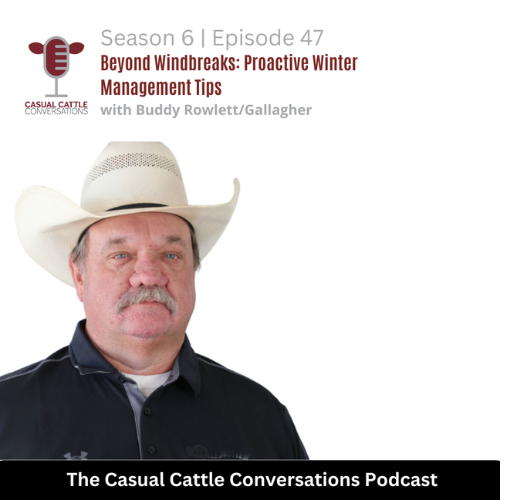The Casual Cattle Conversations Podcast: Beyond Windbreaks: Proactive Winter Management Tips from Gallagher Animal Management
Thursday, November 9, 2023
Reference: Podcast Corner

Beyond Windbreaks: Proactive Winter Management Tips from Gallagher Animal Management
November 6 | Written By Shaye Koester
Buddy Rowlett joins the show from Richmond, Kansas where he raises cattle and works for Gallagher Animal Management. Rowlett shared tips and strategies for working around the challenges winter throws at cattle producers when it comes to winter fencing. This short podcast episode of Casual Cattle Conversations covers the basics of managing added snow pressure with fence design, working with frozen ground and offers a creative solution for electric fences during winter storms.


Click Here to listen to Shaye's Podcast
Snow Pressure & Fence Design
Snow pressure puts extra weight on tapes, wires, posts and corner braces. Your fence design plays a large role in helping your fence get through winter in the best shape possible. Accommodating for snow pressure begins with your corner braces. Rowlett shares that your brace rail should be 2.5 times as long as your fence is tall to reduce the angle of the rail and pressure being placed on the corner post. He also mentions that loosening wires in the winter removes some of the pressure from snow drifts on fence lines and reduces the chance of wires breaking. Temporary electric fences for those who graze residues and stockpile graze will also need extra attention. “The snow and ice load will create added pressures and weight on temporary fences that aren’t experienced during the summer with these fences. You’ll want to add extra posts to accommodate for this,” said Rowlett.Working with the Frozen Ground
The best solution to avoid working with frozen ground is to prepare and build before it freezes. “In the summertime, the ground gets hard if it is dry but not nearly as hard as when a freeze sets in. Get your posts set ahead of time,” said Rowlett. Create a plan for where and when you will need fences, ground rods and energizers to avoid this challenge. Know when you will be grazing which stockpiled forages or crop residues and push these posts in during the fall. If you are using a permanent fence with an electric offset, you don’t have to worry about this challenge as long as your grounding system is already in place.Creative Winter Fencing Strategies
There is usually more than one way to solve a problem Rowlett shares two strategies to help cattle producers get through harsh winters. “When we know there is a storm coming in, we will use bales to create a windbreak and put an electric fence around them. We set the electric fence so that calves can get underneath and bed down beside the bales but it keeps the cows from eating the windbreak,” said Rowlett. Another strategy shared by Rowlett is to loosen any high-tensile wires to help reduce the load on the fence from snowbanks.Other Winter Fencing Considerations
Having hard ground and snow pressure are not the only challenges that need to be overcome during the winter. Rowlett shares that often times temporary posts and tapes are white. This blends in with the snow and makes it difficult for cattle to see the fence. He encourages cattle producers to use green and orange supplies when possible. “Another thing to think about is that dry, powdery snow is more of an insulator than a conductor. Cattle might be standing a few inches of this type of snow and not be getting any shock from the fence. In these instances, we may need to investigate a two-wire system of a hot ground where we are carrying that ground with us,” said Rowlett. And finally, if you are using a solar-powered energizer, be sure to clean snow off of the panel, so that it can continue to charge.May the odds be in your favor this winter!
Sign up to stay connected
- News
- Property Alerts
- Save your favourite properties
- And more!
Joining Farm Marketer is free, easy and you can opt out at any time.
